Design and Implementation of a Smart Home Automation System Project
VerifiedAdded on 2020/04/21
|54
|10472
|46
Project
AI Summary
This project report details the design and implementation of a Smart Home Automation System. The report begins with an introduction outlining the concept, background, problem statement, aims, and objectives, along with constraints, risks, and project plan. It then delves into a literature review, exploring existing studies and business options. The core of the project involves analysis and design, including functional and non-functional requirements, network design, and implementation using Cisco Packet Tracer. The report addresses challenges faced during implementation and provides solutions. Testing methodologies and results are discussed, followed by an evaluation of the project against its objectives and perspectives. The project's conclusion summarizes the overall findings and achievements, emphasizing the successful design and simulation of a smart home automation system.
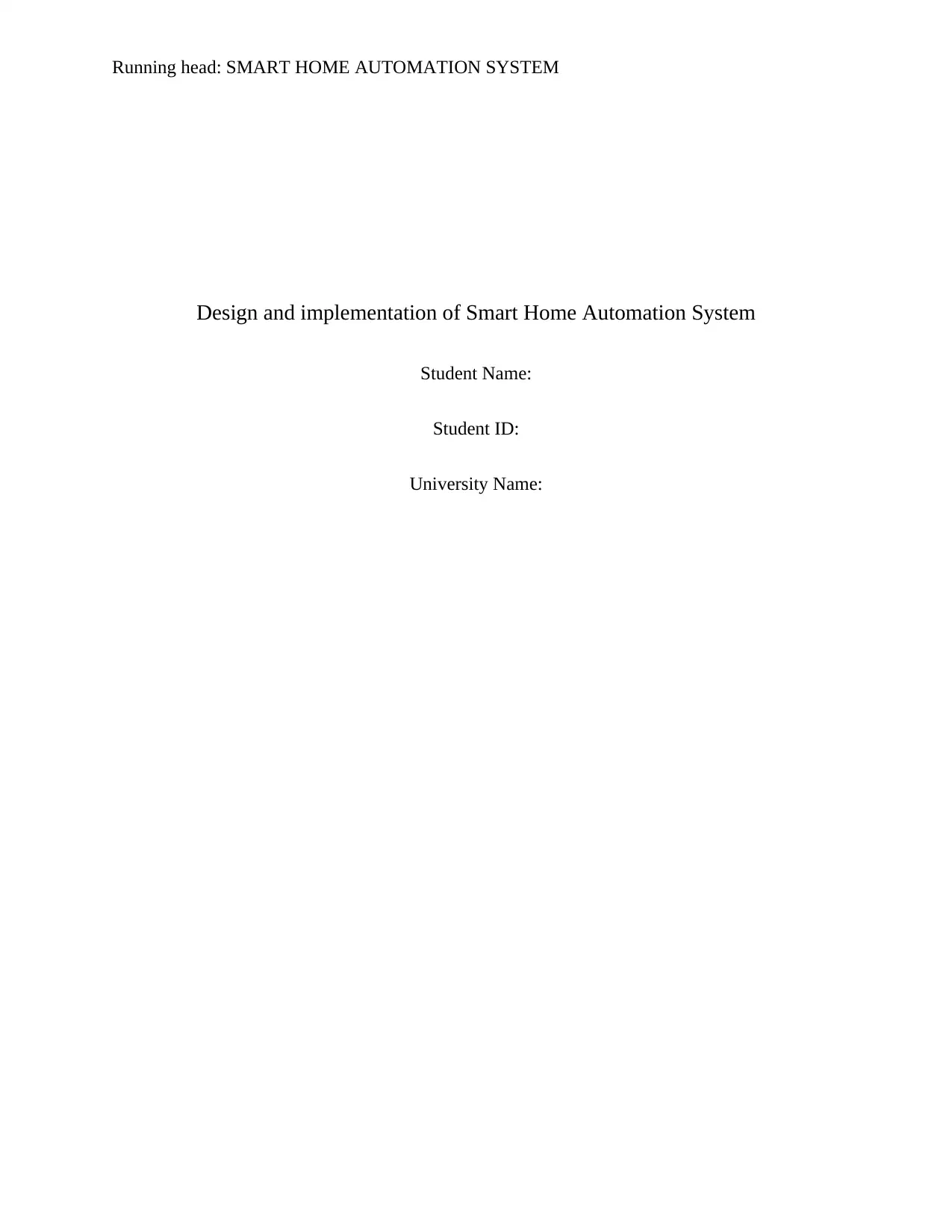
Running head: SMART HOME AUTOMATION SYSTEM
Design and implementation of Smart Home Automation System
Student Name:
Student ID:
University Name:
Design and implementation of Smart Home Automation System
Student Name:
Student ID:
University Name:
Paraphrase This Document
Need a fresh take? Get an instant paraphrase of this document with our AI Paraphraser
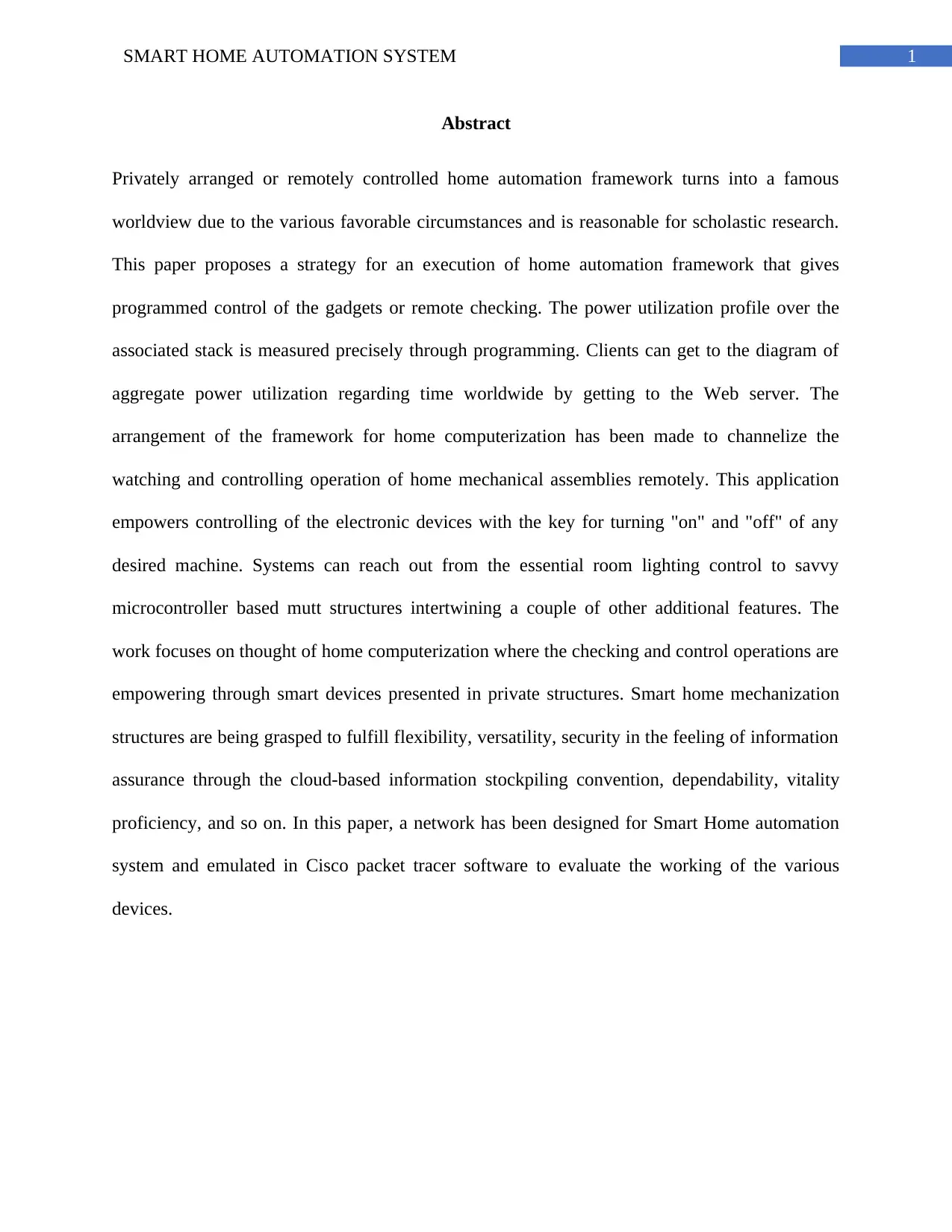
1SMART HOME AUTOMATION SYSTEM
Abstract
Privately arranged or remotely controlled home automation framework turns into a famous
worldview due to the various favorable circumstances and is reasonable for scholastic research.
This paper proposes a strategy for an execution of home automation framework that gives
programmed control of the gadgets or remote checking. The power utilization profile over the
associated stack is measured precisely through programming. Clients can get to the diagram of
aggregate power utilization regarding time worldwide by getting to the Web server. The
arrangement of the framework for home computerization has been made to channelize the
watching and controlling operation of home mechanical assemblies remotely. This application
empowers controlling of the electronic devices with the key for turning "on" and "off" of any
desired machine. Systems can reach out from the essential room lighting control to savvy
microcontroller based mutt structures intertwining a couple of other additional features. The
work focuses on thought of home computerization where the checking and control operations are
empowering through smart devices presented in private structures. Smart home mechanization
structures are being grasped to fulfill flexibility, versatility, security in the feeling of information
assurance through the cloud-based information stockpiling convention, dependability, vitality
proficiency, and so on. In this paper, a network has been designed for Smart Home automation
system and emulated in Cisco packet tracer software to evaluate the working of the various
devices.
Abstract
Privately arranged or remotely controlled home automation framework turns into a famous
worldview due to the various favorable circumstances and is reasonable for scholastic research.
This paper proposes a strategy for an execution of home automation framework that gives
programmed control of the gadgets or remote checking. The power utilization profile over the
associated stack is measured precisely through programming. Clients can get to the diagram of
aggregate power utilization regarding time worldwide by getting to the Web server. The
arrangement of the framework for home computerization has been made to channelize the
watching and controlling operation of home mechanical assemblies remotely. This application
empowers controlling of the electronic devices with the key for turning "on" and "off" of any
desired machine. Systems can reach out from the essential room lighting control to savvy
microcontroller based mutt structures intertwining a couple of other additional features. The
work focuses on thought of home computerization where the checking and control operations are
empowering through smart devices presented in private structures. Smart home mechanization
structures are being grasped to fulfill flexibility, versatility, security in the feeling of information
assurance through the cloud-based information stockpiling convention, dependability, vitality
proficiency, and so on. In this paper, a network has been designed for Smart Home automation
system and emulated in Cisco packet tracer software to evaluate the working of the various
devices.
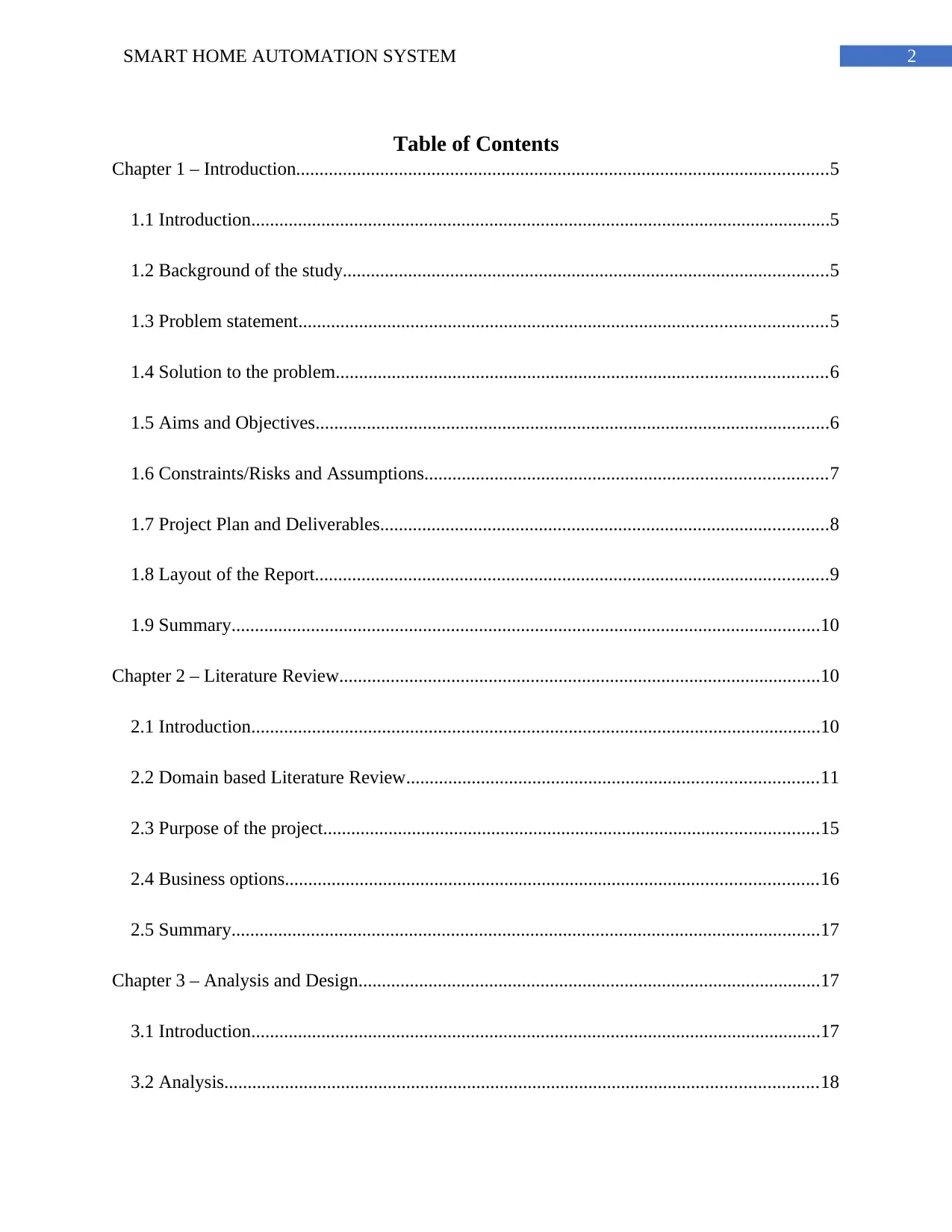
2SMART HOME AUTOMATION SYSTEM
Table of Contents
Chapter 1 – Introduction..................................................................................................................5
1.1 Introduction............................................................................................................................5
1.2 Background of the study........................................................................................................5
1.3 Problem statement.................................................................................................................5
1.4 Solution to the problem.........................................................................................................6
1.5 Aims and Objectives..............................................................................................................6
1.6 Constraints/Risks and Assumptions......................................................................................7
1.7 Project Plan and Deliverables................................................................................................8
1.8 Layout of the Report..............................................................................................................9
1.9 Summary..............................................................................................................................10
Chapter 2 – Literature Review.......................................................................................................10
2.1 Introduction..........................................................................................................................10
2.2 Domain based Literature Review........................................................................................11
2.3 Purpose of the project..........................................................................................................15
2.4 Business options..................................................................................................................16
2.5 Summary..............................................................................................................................17
Chapter 3 – Analysis and Design...................................................................................................17
3.1 Introduction..........................................................................................................................17
3.2 Analysis...............................................................................................................................18
Table of Contents
Chapter 1 – Introduction..................................................................................................................5
1.1 Introduction............................................................................................................................5
1.2 Background of the study........................................................................................................5
1.3 Problem statement.................................................................................................................5
1.4 Solution to the problem.........................................................................................................6
1.5 Aims and Objectives..............................................................................................................6
1.6 Constraints/Risks and Assumptions......................................................................................7
1.7 Project Plan and Deliverables................................................................................................8
1.8 Layout of the Report..............................................................................................................9
1.9 Summary..............................................................................................................................10
Chapter 2 – Literature Review.......................................................................................................10
2.1 Introduction..........................................................................................................................10
2.2 Domain based Literature Review........................................................................................11
2.3 Purpose of the project..........................................................................................................15
2.4 Business options..................................................................................................................16
2.5 Summary..............................................................................................................................17
Chapter 3 – Analysis and Design...................................................................................................17
3.1 Introduction..........................................................................................................................17
3.2 Analysis...............................................................................................................................18
⊘ This is a preview!⊘
Do you want full access?
Subscribe today to unlock all pages.

Trusted by 1+ million students worldwide
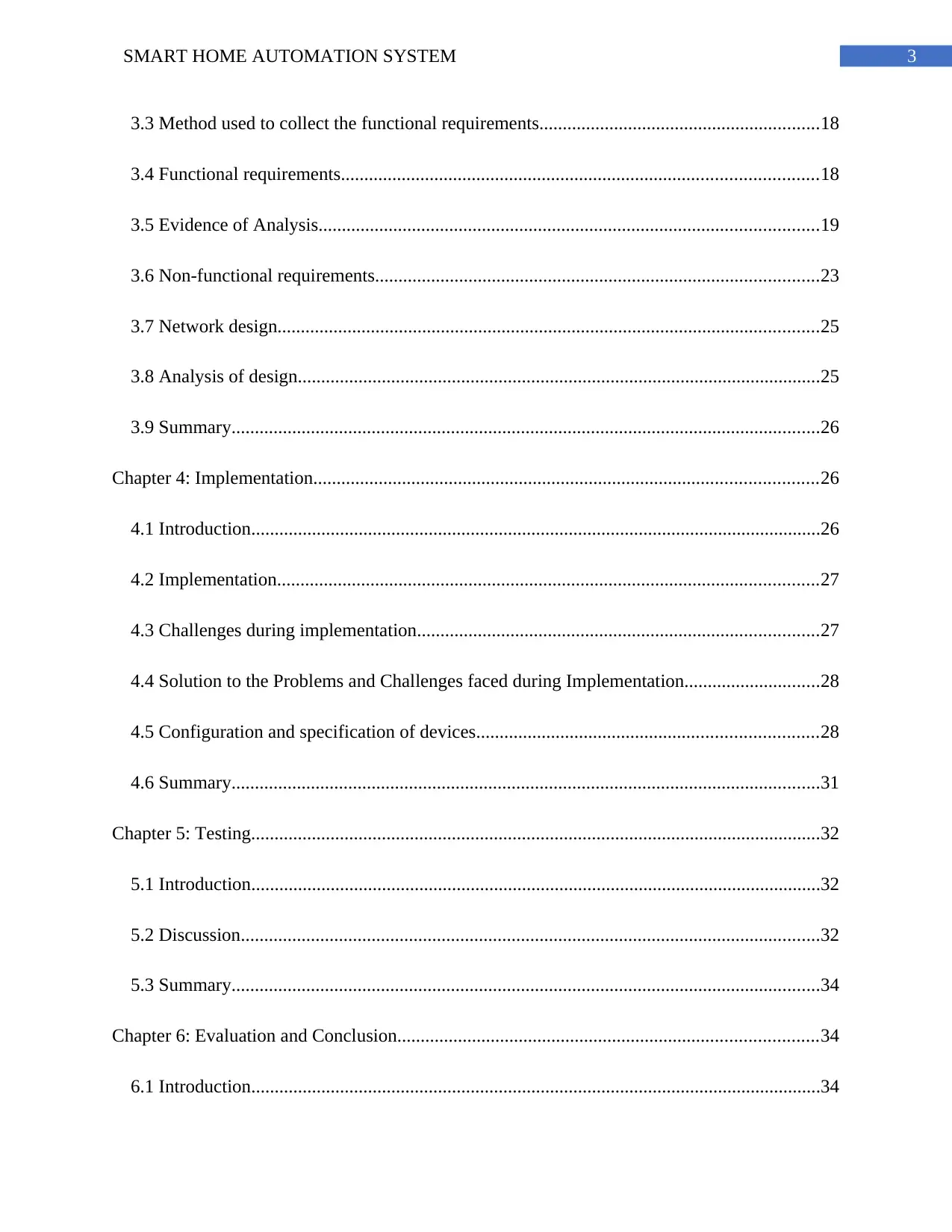
3SMART HOME AUTOMATION SYSTEM
3.3 Method used to collect the functional requirements............................................................18
3.4 Functional requirements......................................................................................................18
3.5 Evidence of Analysis...........................................................................................................19
3.6 Non-functional requirements...............................................................................................23
3.7 Network design....................................................................................................................25
3.8 Analysis of design................................................................................................................25
3.9 Summary..............................................................................................................................26
Chapter 4: Implementation............................................................................................................26
4.1 Introduction..........................................................................................................................26
4.2 Implementation....................................................................................................................27
4.3 Challenges during implementation......................................................................................27
4.4 Solution to the Problems and Challenges faced during Implementation.............................28
4.5 Configuration and specification of devices.........................................................................28
4.6 Summary..............................................................................................................................31
Chapter 5: Testing..........................................................................................................................32
5.1 Introduction..........................................................................................................................32
5.2 Discussion............................................................................................................................32
5.3 Summary..............................................................................................................................34
Chapter 6: Evaluation and Conclusion..........................................................................................34
6.1 Introduction..........................................................................................................................34
3.3 Method used to collect the functional requirements............................................................18
3.4 Functional requirements......................................................................................................18
3.5 Evidence of Analysis...........................................................................................................19
3.6 Non-functional requirements...............................................................................................23
3.7 Network design....................................................................................................................25
3.8 Analysis of design................................................................................................................25
3.9 Summary..............................................................................................................................26
Chapter 4: Implementation............................................................................................................26
4.1 Introduction..........................................................................................................................26
4.2 Implementation....................................................................................................................27
4.3 Challenges during implementation......................................................................................27
4.4 Solution to the Problems and Challenges faced during Implementation.............................28
4.5 Configuration and specification of devices.........................................................................28
4.6 Summary..............................................................................................................................31
Chapter 5: Testing..........................................................................................................................32
5.1 Introduction..........................................................................................................................32
5.2 Discussion............................................................................................................................32
5.3 Summary..............................................................................................................................34
Chapter 6: Evaluation and Conclusion..........................................................................................34
6.1 Introduction..........................................................................................................................34
Paraphrase This Document
Need a fresh take? Get an instant paraphrase of this document with our AI Paraphraser
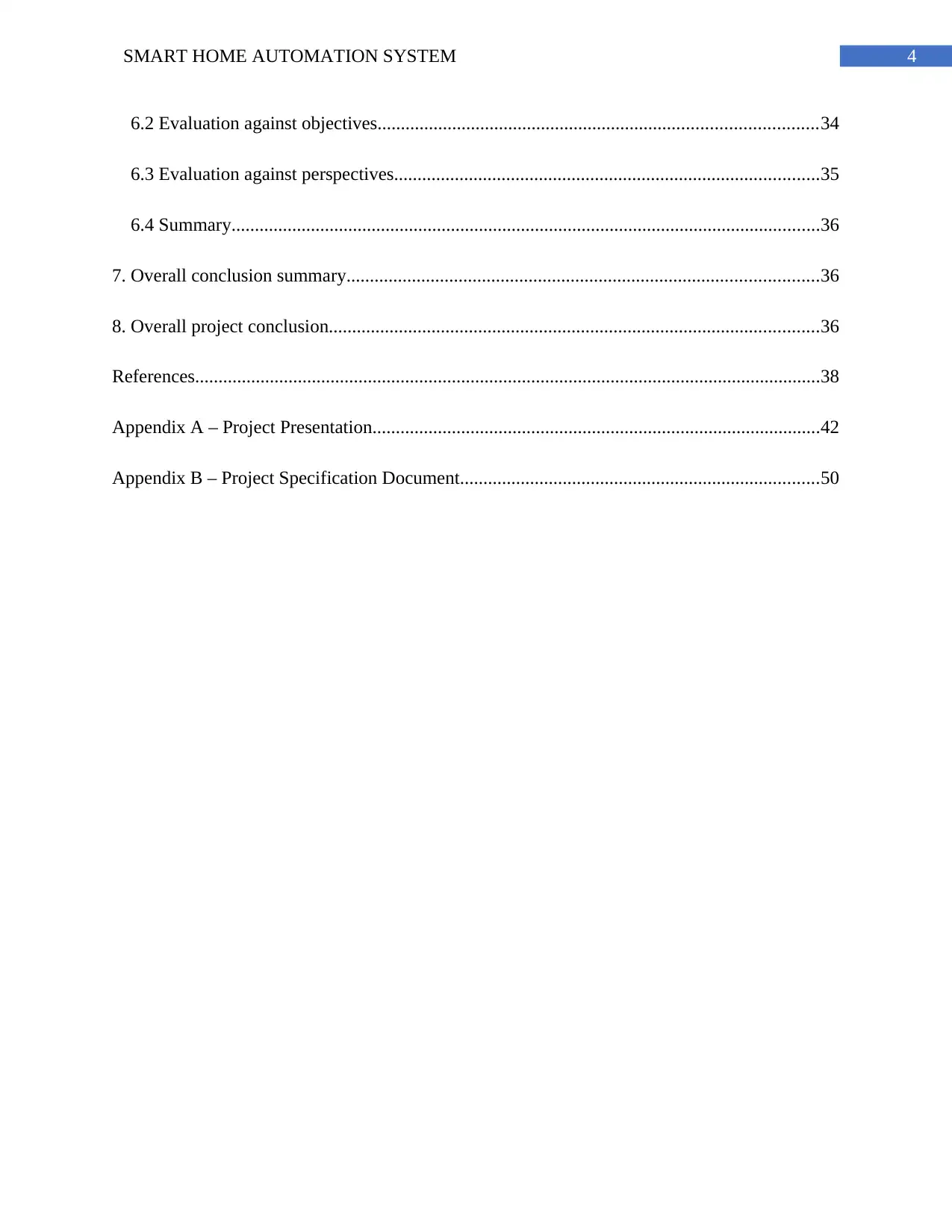
4SMART HOME AUTOMATION SYSTEM
6.2 Evaluation against objectives..............................................................................................34
6.3 Evaluation against perspectives...........................................................................................35
6.4 Summary..............................................................................................................................36
7. Overall conclusion summary.....................................................................................................36
8. Overall project conclusion.........................................................................................................36
References......................................................................................................................................38
Appendix A – Project Presentation................................................................................................42
Appendix B – Project Specification Document.............................................................................50
6.2 Evaluation against objectives..............................................................................................34
6.3 Evaluation against perspectives...........................................................................................35
6.4 Summary..............................................................................................................................36
7. Overall conclusion summary.....................................................................................................36
8. Overall project conclusion.........................................................................................................36
References......................................................................................................................................38
Appendix A – Project Presentation................................................................................................42
Appendix B – Project Specification Document.............................................................................50
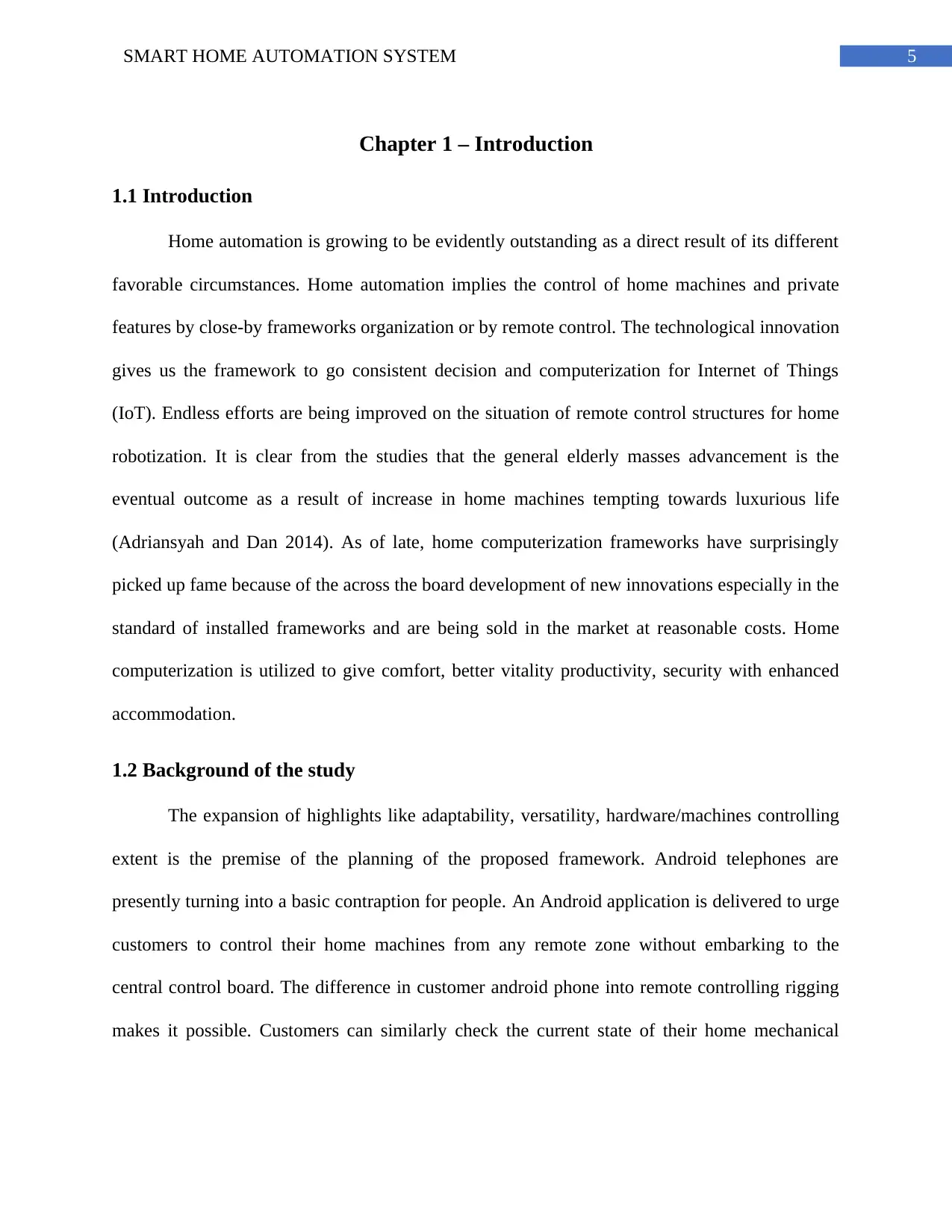
5SMART HOME AUTOMATION SYSTEM
Chapter 1 – Introduction
1.1 Introduction
Home automation is growing to be evidently outstanding as a direct result of its different
favorable circumstances. Home automation implies the control of home machines and private
features by close-by frameworks organization or by remote control. The technological innovation
gives us the framework to go consistent decision and computerization for Internet of Things
(IoT). Endless efforts are being improved on the situation of remote control structures for home
robotization. It is clear from the studies that the general elderly masses advancement is the
eventual outcome as a result of increase in home machines tempting towards luxurious life
(Adriansyah and Dan 2014). As of late, home computerization frameworks have surprisingly
picked up fame because of the across the board development of new innovations especially in the
standard of installed frameworks and are being sold in the market at reasonable costs. Home
computerization is utilized to give comfort, better vitality productivity, security with enhanced
accommodation.
1.2 Background of the study
The expansion of highlights like adaptability, versatility, hardware/machines controlling
extent is the premise of the planning of the proposed framework. Android telephones are
presently turning into a basic contraption for people. An Android application is delivered to urge
customers to control their home machines from any remote zone without embarking to the
central control board. The difference in customer android phone into remote controlling rigging
makes it possible. Customers can similarly check the current state of their home mechanical
Chapter 1 – Introduction
1.1 Introduction
Home automation is growing to be evidently outstanding as a direct result of its different
favorable circumstances. Home automation implies the control of home machines and private
features by close-by frameworks organization or by remote control. The technological innovation
gives us the framework to go consistent decision and computerization for Internet of Things
(IoT). Endless efforts are being improved on the situation of remote control structures for home
robotization. It is clear from the studies that the general elderly masses advancement is the
eventual outcome as a result of increase in home machines tempting towards luxurious life
(Adriansyah and Dan 2014). As of late, home computerization frameworks have surprisingly
picked up fame because of the across the board development of new innovations especially in the
standard of installed frameworks and are being sold in the market at reasonable costs. Home
computerization is utilized to give comfort, better vitality productivity, security with enhanced
accommodation.
1.2 Background of the study
The expansion of highlights like adaptability, versatility, hardware/machines controlling
extent is the premise of the planning of the proposed framework. Android telephones are
presently turning into a basic contraption for people. An Android application is delivered to urge
customers to control their home machines from any remote zone without embarking to the
central control board. The difference in customer android phone into remote controlling rigging
makes it possible. Customers can similarly check the current state of their home mechanical
⊘ This is a preview!⊘
Do you want full access?
Subscribe today to unlock all pages.

Trusted by 1+ million students worldwide
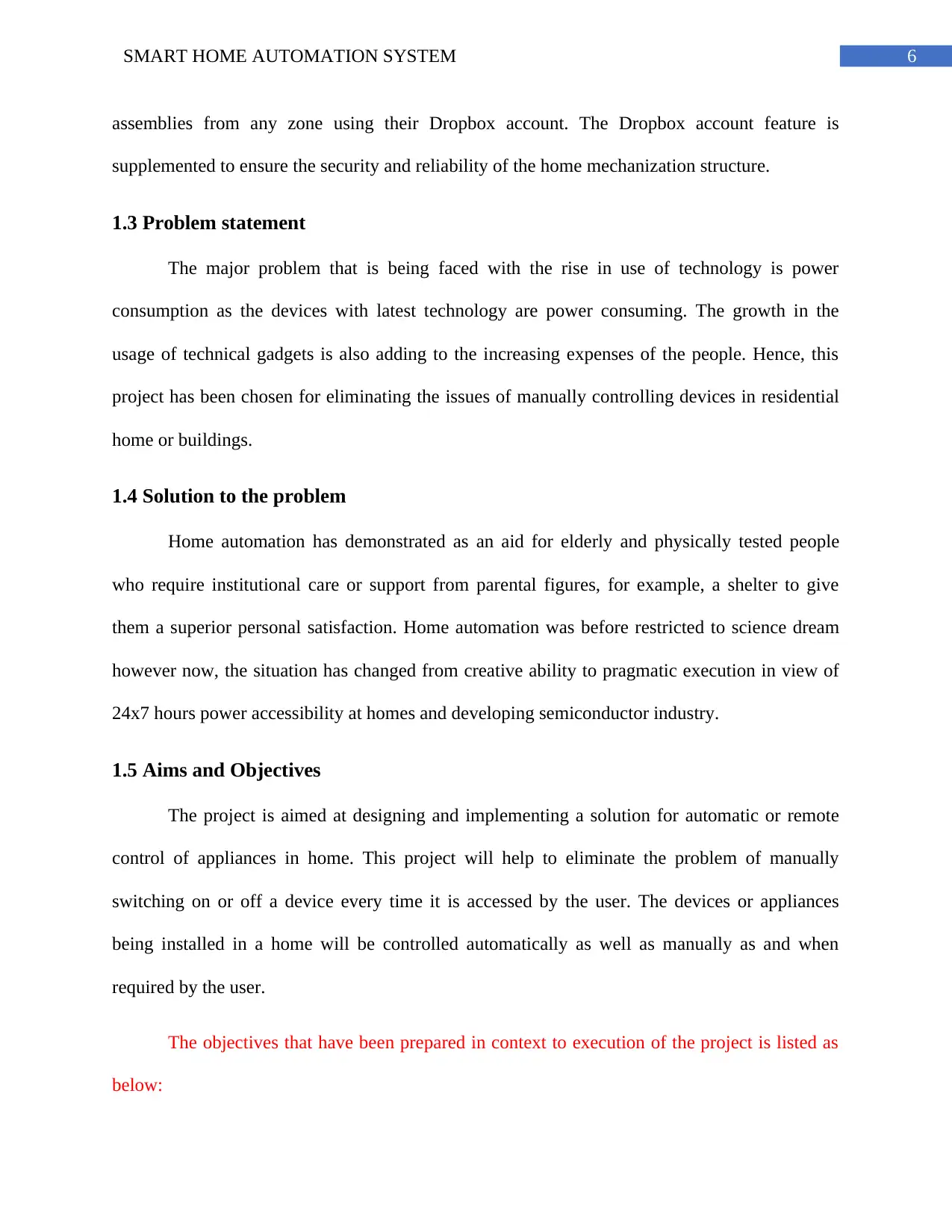
6SMART HOME AUTOMATION SYSTEM
assemblies from any zone using their Dropbox account. The Dropbox account feature is
supplemented to ensure the security and reliability of the home mechanization structure.
1.3 Problem statement
The major problem that is being faced with the rise in use of technology is power
consumption as the devices with latest technology are power consuming. The growth in the
usage of technical gadgets is also adding to the increasing expenses of the people. Hence, this
project has been chosen for eliminating the issues of manually controlling devices in residential
home or buildings.
1.4 Solution to the problem
Home automation has demonstrated as an aid for elderly and physically tested people
who require institutional care or support from parental figures, for example, a shelter to give
them a superior personal satisfaction. Home automation was before restricted to science dream
however now, the situation has changed from creative ability to pragmatic execution in view of
24x7 hours power accessibility at homes and developing semiconductor industry.
1.5 Aims and Objectives
The project is aimed at designing and implementing a solution for automatic or remote
control of appliances in home. This project will help to eliminate the problem of manually
switching on or off a device every time it is accessed by the user. The devices or appliances
being installed in a home will be controlled automatically as well as manually as and when
required by the user.
The objectives that have been prepared in context to execution of the project is listed as
below:
assemblies from any zone using their Dropbox account. The Dropbox account feature is
supplemented to ensure the security and reliability of the home mechanization structure.
1.3 Problem statement
The major problem that is being faced with the rise in use of technology is power
consumption as the devices with latest technology are power consuming. The growth in the
usage of technical gadgets is also adding to the increasing expenses of the people. Hence, this
project has been chosen for eliminating the issues of manually controlling devices in residential
home or buildings.
1.4 Solution to the problem
Home automation has demonstrated as an aid for elderly and physically tested people
who require institutional care or support from parental figures, for example, a shelter to give
them a superior personal satisfaction. Home automation was before restricted to science dream
however now, the situation has changed from creative ability to pragmatic execution in view of
24x7 hours power accessibility at homes and developing semiconductor industry.
1.5 Aims and Objectives
The project is aimed at designing and implementing a solution for automatic or remote
control of appliances in home. This project will help to eliminate the problem of manually
switching on or off a device every time it is accessed by the user. The devices or appliances
being installed in a home will be controlled automatically as well as manually as and when
required by the user.
The objectives that have been prepared in context to execution of the project is listed as
below:
Paraphrase This Document
Need a fresh take? Get an instant paraphrase of this document with our AI Paraphraser
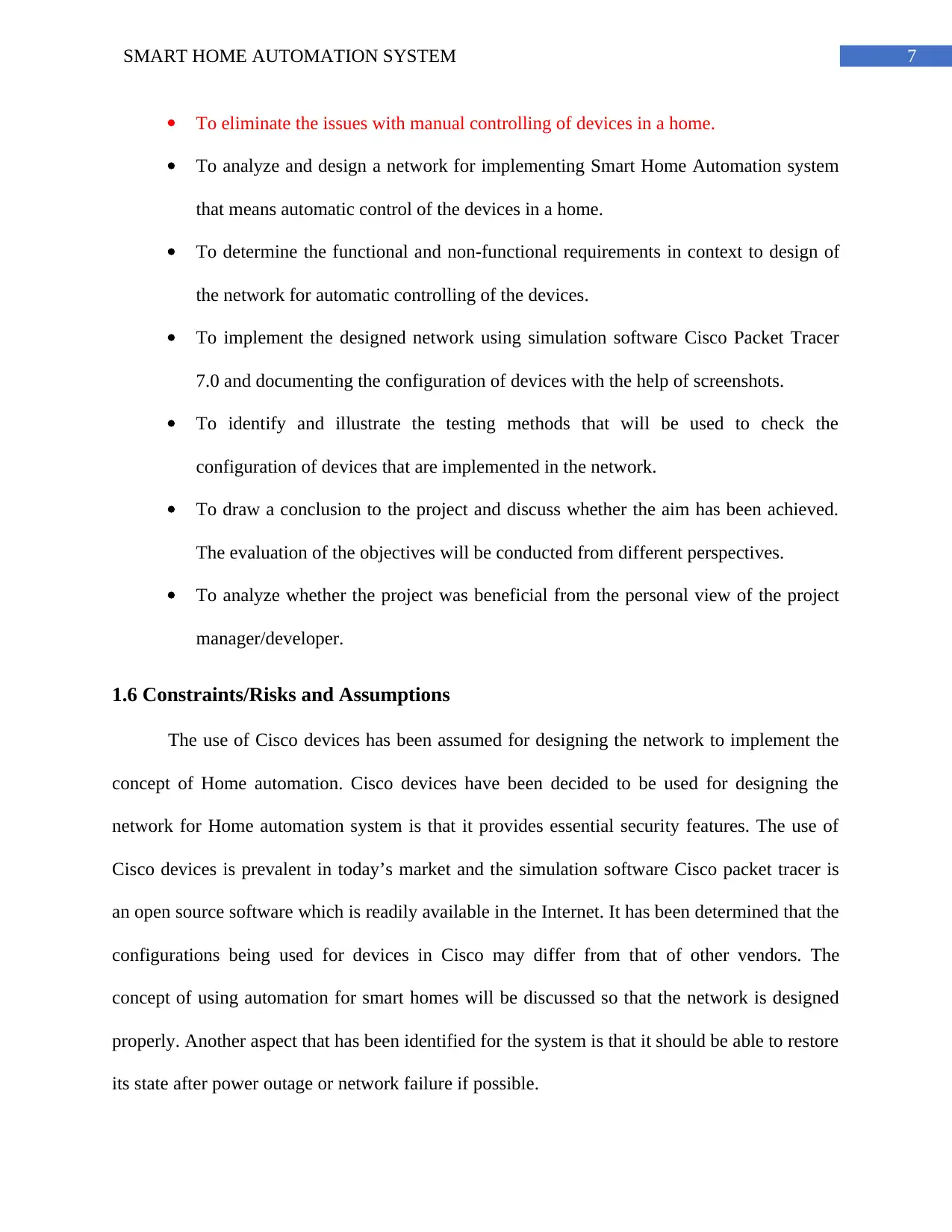
7SMART HOME AUTOMATION SYSTEM
To eliminate the issues with manual controlling of devices in a home.
To analyze and design a network for implementing Smart Home Automation system
that means automatic control of the devices in a home.
To determine the functional and non-functional requirements in context to design of
the network for automatic controlling of the devices.
To implement the designed network using simulation software Cisco Packet Tracer
7.0 and documenting the configuration of devices with the help of screenshots.
To identify and illustrate the testing methods that will be used to check the
configuration of devices that are implemented in the network.
To draw a conclusion to the project and discuss whether the aim has been achieved.
The evaluation of the objectives will be conducted from different perspectives.
To analyze whether the project was beneficial from the personal view of the project
manager/developer.
1.6 Constraints/Risks and Assumptions
The use of Cisco devices has been assumed for designing the network to implement the
concept of Home automation. Cisco devices have been decided to be used for designing the
network for Home automation system is that it provides essential security features. The use of
Cisco devices is prevalent in today’s market and the simulation software Cisco packet tracer is
an open source software which is readily available in the Internet. It has been determined that the
configurations being used for devices in Cisco may differ from that of other vendors. The
concept of using automation for smart homes will be discussed so that the network is designed
properly. Another aspect that has been identified for the system is that it should be able to restore
its state after power outage or network failure if possible.
To eliminate the issues with manual controlling of devices in a home.
To analyze and design a network for implementing Smart Home Automation system
that means automatic control of the devices in a home.
To determine the functional and non-functional requirements in context to design of
the network for automatic controlling of the devices.
To implement the designed network using simulation software Cisco Packet Tracer
7.0 and documenting the configuration of devices with the help of screenshots.
To identify and illustrate the testing methods that will be used to check the
configuration of devices that are implemented in the network.
To draw a conclusion to the project and discuss whether the aim has been achieved.
The evaluation of the objectives will be conducted from different perspectives.
To analyze whether the project was beneficial from the personal view of the project
manager/developer.
1.6 Constraints/Risks and Assumptions
The use of Cisco devices has been assumed for designing the network to implement the
concept of Home automation. Cisco devices have been decided to be used for designing the
network for Home automation system is that it provides essential security features. The use of
Cisco devices is prevalent in today’s market and the simulation software Cisco packet tracer is
an open source software which is readily available in the Internet. It has been determined that the
configurations being used for devices in Cisco may differ from that of other vendors. The
concept of using automation for smart homes will be discussed so that the network is designed
properly. Another aspect that has been identified for the system is that it should be able to restore
its state after power outage or network failure if possible.
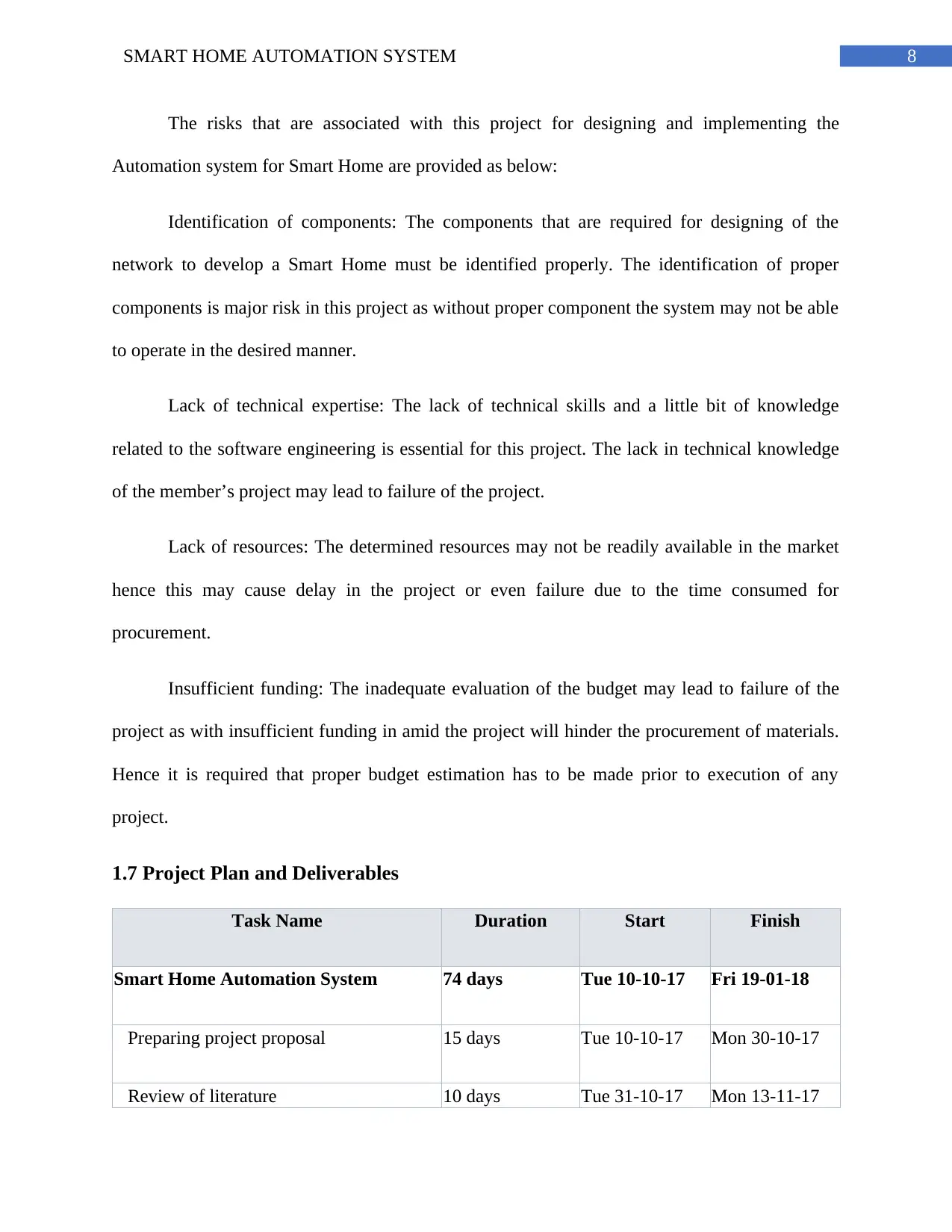
8SMART HOME AUTOMATION SYSTEM
The risks that are associated with this project for designing and implementing the
Automation system for Smart Home are provided as below:
Identification of components: The components that are required for designing of the
network to develop a Smart Home must be identified properly. The identification of proper
components is major risk in this project as without proper component the system may not be able
to operate in the desired manner.
Lack of technical expertise: The lack of technical skills and a little bit of knowledge
related to the software engineering is essential for this project. The lack in technical knowledge
of the member’s project may lead to failure of the project.
Lack of resources: The determined resources may not be readily available in the market
hence this may cause delay in the project or even failure due to the time consumed for
procurement.
Insufficient funding: The inadequate evaluation of the budget may lead to failure of the
project as with insufficient funding in amid the project will hinder the procurement of materials.
Hence it is required that proper budget estimation has to be made prior to execution of any
project.
1.7 Project Plan and Deliverables
Task Name Duration Start Finish
Smart Home Automation System 74 days Tue 10-10-17 Fri 19-01-18
Preparing project proposal 15 days Tue 10-10-17 Mon 30-10-17
Review of literature 10 days Tue 31-10-17 Mon 13-11-17
The risks that are associated with this project for designing and implementing the
Automation system for Smart Home are provided as below:
Identification of components: The components that are required for designing of the
network to develop a Smart Home must be identified properly. The identification of proper
components is major risk in this project as without proper component the system may not be able
to operate in the desired manner.
Lack of technical expertise: The lack of technical skills and a little bit of knowledge
related to the software engineering is essential for this project. The lack in technical knowledge
of the member’s project may lead to failure of the project.
Lack of resources: The determined resources may not be readily available in the market
hence this may cause delay in the project or even failure due to the time consumed for
procurement.
Insufficient funding: The inadequate evaluation of the budget may lead to failure of the
project as with insufficient funding in amid the project will hinder the procurement of materials.
Hence it is required that proper budget estimation has to be made prior to execution of any
project.
1.7 Project Plan and Deliverables
Task Name Duration Start Finish
Smart Home Automation System 74 days Tue 10-10-17 Fri 19-01-18
Preparing project proposal 15 days Tue 10-10-17 Mon 30-10-17
Review of literature 10 days Tue 31-10-17 Mon 13-11-17
⊘ This is a preview!⊘
Do you want full access?
Subscribe today to unlock all pages.

Trusted by 1+ million students worldwide
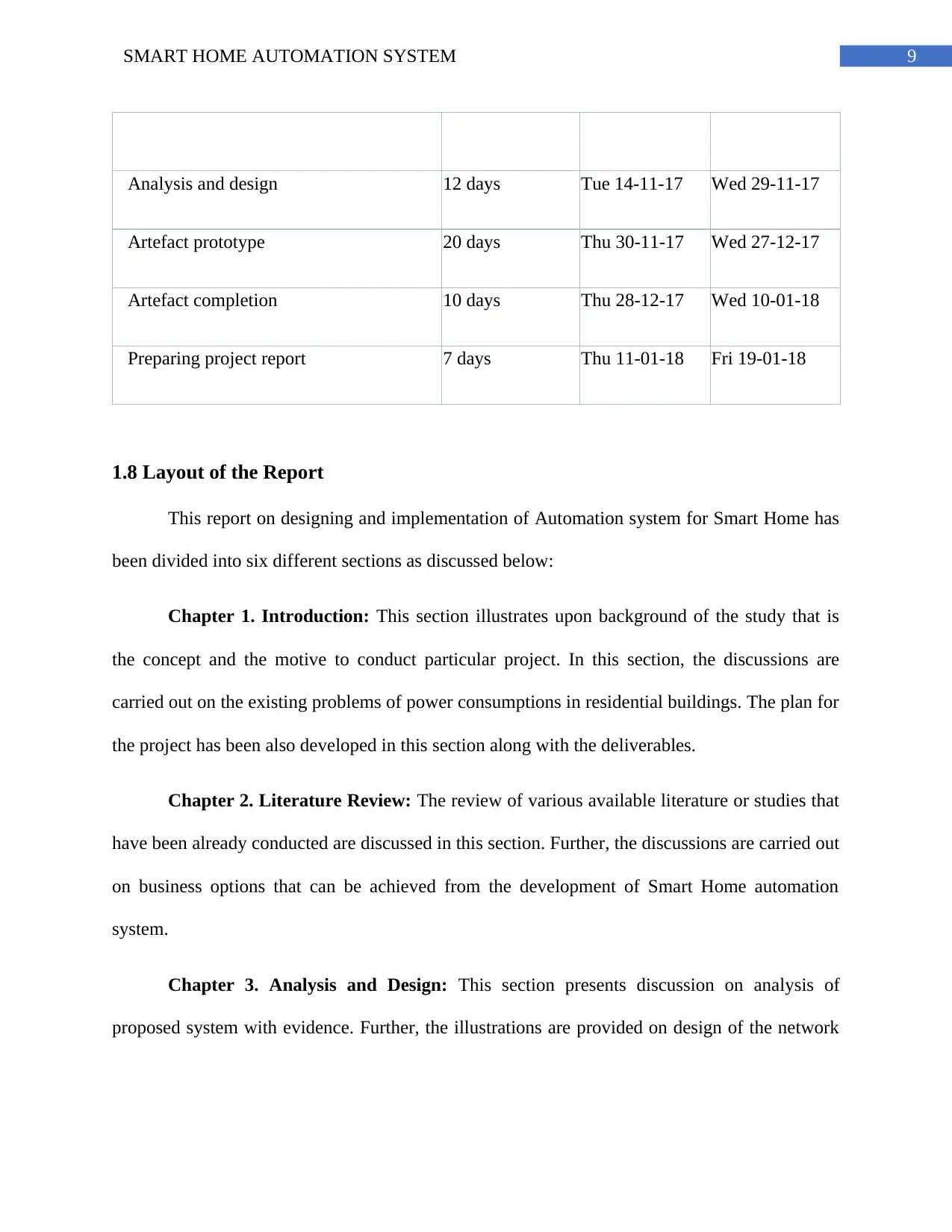
9SMART HOME AUTOMATION SYSTEM
Analysis and design 12 days Tue 14-11-17 Wed 29-11-17
Artefact prototype 20 days Thu 30-11-17 Wed 27-12-17
Artefact completion 10 days Thu 28-12-17 Wed 10-01-18
Preparing project report 7 days Thu 11-01-18 Fri 19-01-18
1.8 Layout of the Report
This report on designing and implementation of Automation system for Smart Home has
been divided into six different sections as discussed below:
Chapter 1. Introduction: This section illustrates upon background of the study that is
the concept and the motive to conduct particular project. In this section, the discussions are
carried out on the existing problems of power consumptions in residential buildings. The plan for
the project has been also developed in this section along with the deliverables.
Chapter 2. Literature Review: The review of various available literature or studies that
have been already conducted are discussed in this section. Further, the discussions are carried out
on business options that can be achieved from the development of Smart Home automation
system.
Chapter 3. Analysis and Design: This section presents discussion on analysis of
proposed system with evidence. Further, the illustrations are provided on design of the network
Analysis and design 12 days Tue 14-11-17 Wed 29-11-17
Artefact prototype 20 days Thu 30-11-17 Wed 27-12-17
Artefact completion 10 days Thu 28-12-17 Wed 10-01-18
Preparing project report 7 days Thu 11-01-18 Fri 19-01-18
1.8 Layout of the Report
This report on designing and implementation of Automation system for Smart Home has
been divided into six different sections as discussed below:
Chapter 1. Introduction: This section illustrates upon background of the study that is
the concept and the motive to conduct particular project. In this section, the discussions are
carried out on the existing problems of power consumptions in residential buildings. The plan for
the project has been also developed in this section along with the deliverables.
Chapter 2. Literature Review: The review of various available literature or studies that
have been already conducted are discussed in this section. Further, the discussions are carried out
on business options that can be achieved from the development of Smart Home automation
system.
Chapter 3. Analysis and Design: This section presents discussion on analysis of
proposed system with evidence. Further, the illustrations are provided on design of the network
Paraphrase This Document
Need a fresh take? Get an instant paraphrase of this document with our AI Paraphraser
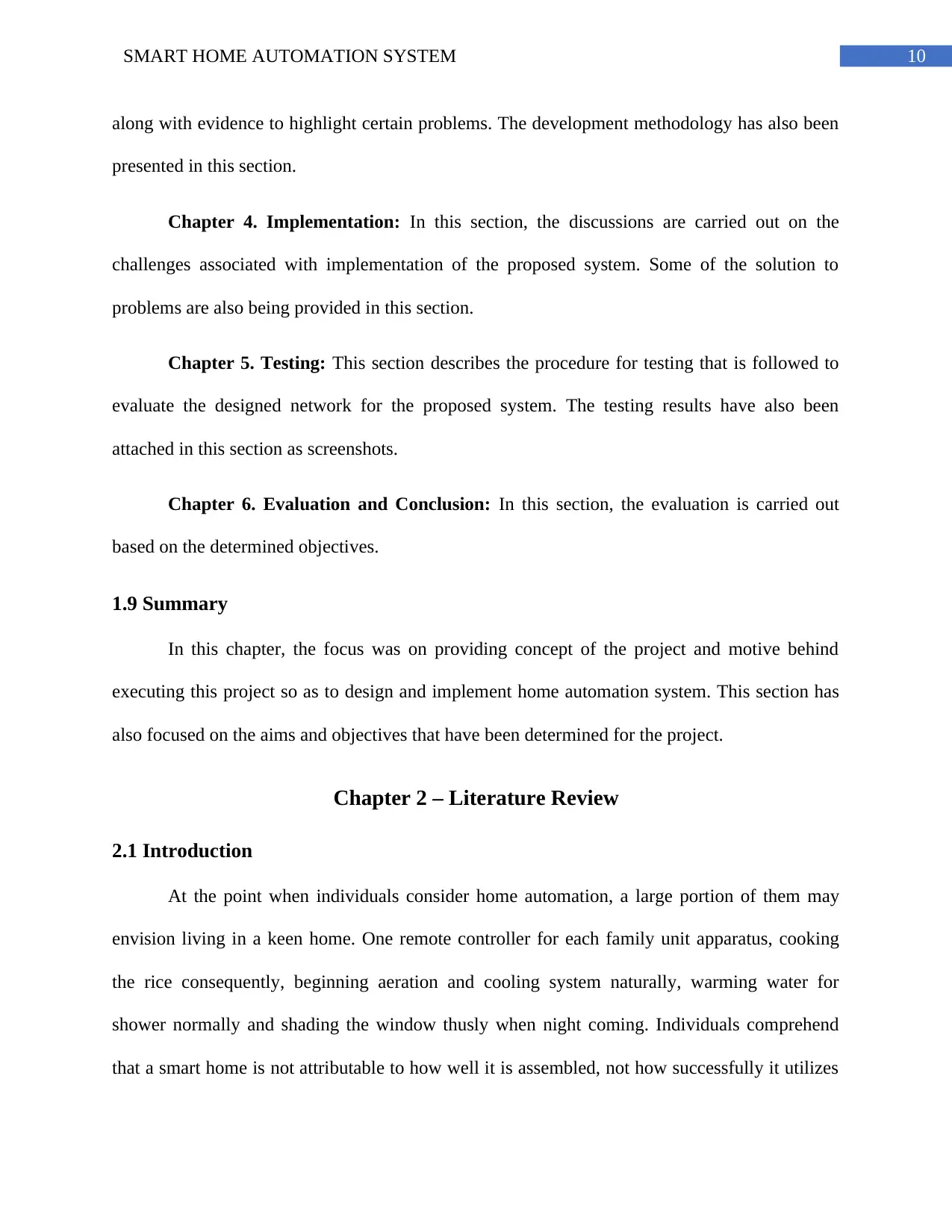
10SMART HOME AUTOMATION SYSTEM
along with evidence to highlight certain problems. The development methodology has also been
presented in this section.
Chapter 4. Implementation: In this section, the discussions are carried out on the
challenges associated with implementation of the proposed system. Some of the solution to
problems are also being provided in this section.
Chapter 5. Testing: This section describes the procedure for testing that is followed to
evaluate the designed network for the proposed system. The testing results have also been
attached in this section as screenshots.
Chapter 6. Evaluation and Conclusion: In this section, the evaluation is carried out
based on the determined objectives.
1.9 Summary
In this chapter, the focus was on providing concept of the project and motive behind
executing this project so as to design and implement home automation system. This section has
also focused on the aims and objectives that have been determined for the project.
Chapter 2 – Literature Review
2.1 Introduction
At the point when individuals consider home automation, a large portion of them may
envision living in a keen home. One remote controller for each family unit apparatus, cooking
the rice consequently, beginning aeration and cooling system naturally, warming water for
shower normally and shading the window thusly when night coming. Individuals comprehend
that a smart home is not attributable to how well it is assembled, not how successfully it utilizes
along with evidence to highlight certain problems. The development methodology has also been
presented in this section.
Chapter 4. Implementation: In this section, the discussions are carried out on the
challenges associated with implementation of the proposed system. Some of the solution to
problems are also being provided in this section.
Chapter 5. Testing: This section describes the procedure for testing that is followed to
evaluate the designed network for the proposed system. The testing results have also been
attached in this section as screenshots.
Chapter 6. Evaluation and Conclusion: In this section, the evaluation is carried out
based on the determined objectives.
1.9 Summary
In this chapter, the focus was on providing concept of the project and motive behind
executing this project so as to design and implement home automation system. This section has
also focused on the aims and objectives that have been determined for the project.
Chapter 2 – Literature Review
2.1 Introduction
At the point when individuals consider home automation, a large portion of them may
envision living in a keen home. One remote controller for each family unit apparatus, cooking
the rice consequently, beginning aeration and cooling system naturally, warming water for
shower normally and shading the window thusly when night coming. Individuals comprehend
that a smart home is not attributable to how well it is assembled, not how successfully it utilizes
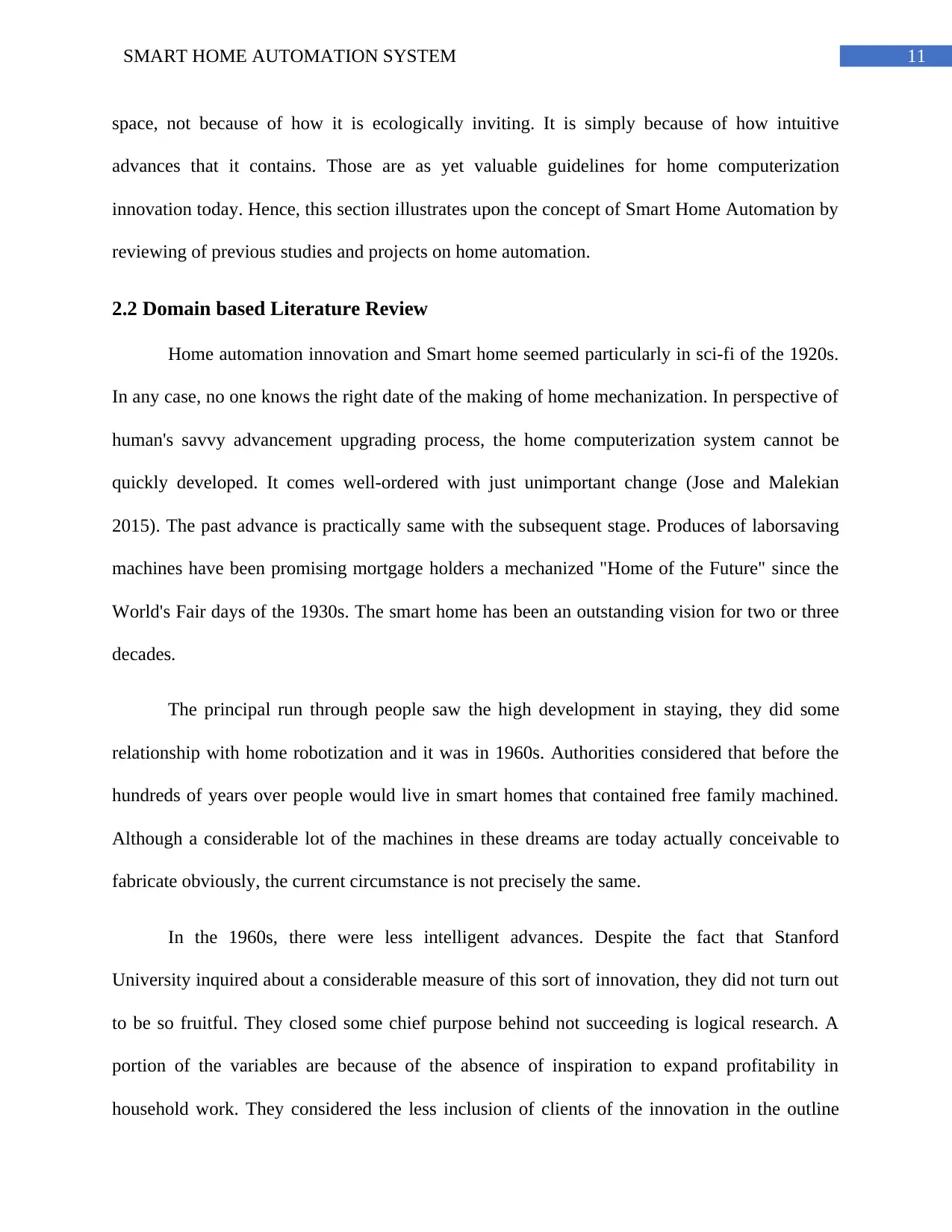
11SMART HOME AUTOMATION SYSTEM
space, not because of how it is ecologically inviting. It is simply because of how intuitive
advances that it contains. Those are as yet valuable guidelines for home computerization
innovation today. Hence, this section illustrates upon the concept of Smart Home Automation by
reviewing of previous studies and projects on home automation.
2.2 Domain based Literature Review
Home automation innovation and Smart home seemed particularly in sci-fi of the 1920s.
In any case, no one knows the right date of the making of home mechanization. In perspective of
human's savvy advancement upgrading process, the home computerization system cannot be
quickly developed. It comes well-ordered with just unimportant change (Jose and Malekian
2015). The past advance is practically same with the subsequent stage. Produces of laborsaving
machines have been promising mortgage holders a mechanized "Home of the Future" since the
World's Fair days of the 1930s. The smart home has been an outstanding vision for two or three
decades.
The principal run through people saw the high development in staying, they did some
relationship with home robotization and it was in 1960s. Authorities considered that before the
hundreds of years over people would live in smart homes that contained free family machined.
Although a considerable lot of the machines in these dreams are today actually conceivable to
fabricate obviously, the current circumstance is not precisely the same.
In the 1960s, there were less intelligent advances. Despite the fact that Stanford
University inquired about a considerable measure of this sort of innovation, they did not turn out
to be so fruitful. They closed some chief purpose behind not succeeding is logical research. A
portion of the variables are because of the absence of inspiration to expand profitability in
household work. They considered the less inclusion of clients of the innovation in the outline
space, not because of how it is ecologically inviting. It is simply because of how intuitive
advances that it contains. Those are as yet valuable guidelines for home computerization
innovation today. Hence, this section illustrates upon the concept of Smart Home Automation by
reviewing of previous studies and projects on home automation.
2.2 Domain based Literature Review
Home automation innovation and Smart home seemed particularly in sci-fi of the 1920s.
In any case, no one knows the right date of the making of home mechanization. In perspective of
human's savvy advancement upgrading process, the home computerization system cannot be
quickly developed. It comes well-ordered with just unimportant change (Jose and Malekian
2015). The past advance is practically same with the subsequent stage. Produces of laborsaving
machines have been promising mortgage holders a mechanized "Home of the Future" since the
World's Fair days of the 1930s. The smart home has been an outstanding vision for two or three
decades.
The principal run through people saw the high development in staying, they did some
relationship with home robotization and it was in 1960s. Authorities considered that before the
hundreds of years over people would live in smart homes that contained free family machined.
Although a considerable lot of the machines in these dreams are today actually conceivable to
fabricate obviously, the current circumstance is not precisely the same.
In the 1960s, there were less intelligent advances. Despite the fact that Stanford
University inquired about a considerable measure of this sort of innovation, they did not turn out
to be so fruitful. They closed some chief purpose behind not succeeding is logical research. A
portion of the variables are because of the absence of inspiration to expand profitability in
household work. They considered the less inclusion of clients of the innovation in the outline
⊘ This is a preview!⊘
Do you want full access?
Subscribe today to unlock all pages.

Trusted by 1+ million students worldwide
1 out of 54
Related Documents
Your All-in-One AI-Powered Toolkit for Academic Success.
+13062052269
info@desklib.com
Available 24*7 on WhatsApp / Email
![[object Object]](/_next/static/media/star-bottom.7253800d.svg)
Unlock your academic potential
Copyright © 2020–2025 A2Z Services. All Rights Reserved. Developed and managed by ZUCOL.

